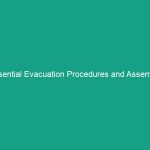Good Morning Team!
Today, we’re here to discuss an important topic: Essential HSE Guidelines: Avoid Common Risks in the Workplace. Understanding and applying these guidelines is crucial for maintaining a safe work Environment and protecting our health and Safety. Let’s dive into why these guidelines matter and how they can impact our daily operations.
Understanding Essential HSE Guidelines
Essential HSE guidelines refer to the set of practices and Regulations designed to safeguard the health, safety, and environment of employees in the workplace. These guidelines are not just bureaucratic red tape; they are vital for preventing accidents, injuries, and even fatalities. Misunderstanding or ignoring these guidelines can lead to severe consequences, affecting not only individual employees but also the entire organization.
Many employees may think that HSE guidelines only apply to certain roles or environments, but the reality is that they are relevant to everyone, regardless of position or location. Compliance with these guidelines ensures that we all contribute to a culture of Safety.
Key Hazards, Risks, and Safety Considerations
In any workplace, several common Hazards and risks can arise. Here are some key areas to consider:
- Slips, Trips, and Falls: These are among the most common workplace accidents. Floors can be wet or cluttered, leading to dangerous situations.
- Electrical Hazards: Faulty wiring, overloaded circuits, and improper use of electrical equipment can lead to shocks or Fires.
- Hazardous Materials: Exposure to chemicals or toxic substances can cause serious health issues over time.
- Ergonomic Risks: Poor workstation setups can lead to musculoskeletal disorders, affecting long-term health.
Ignoring safety protocols can lead to real-world consequences, including injuries that can result in lost time, increased insurance costs, and a decrease in overall productivity. It is essential to recognize these risks and take proactive measures to mitigate them.
Best Practices, Procedures, & Actionable Advice
Step-by-Step Safety Procedures
To create a safer workplace, follow these Best Practices:
- Conduct Regular Safety Training: Ensure that all employees receive proper training on HSE guidelines and emergency procedures.
- Keep Workspaces Organized: Maintain a clean and tidy working environment to reduce trip hazards.
- Use Personal Protective Equipment (PPE): Always wear appropriate PPE for your job, such as helmets, gloves, and goggles.
- Report Hazards Immediately: Encourage employees to report any unsafe conditions or behaviors to management without fear of repercussions.
Real-Life Examples of Safety Lessons
Let’s consider a case study: In a manufacturing plant, an employee slipped on a wet floor and suffered a serious injury. This incident could have been prevented by implementing a simple checklist to ensure floors were dry and clear of obstacles. This example underscores the importance of vigilance and proactive Safety Measures.
Regulations, Standards, and Compliance
Adhering to regulations is crucial for maintaining a safe workplace. Familiarize yourself with relevant Standards such as:
- Occupational Safety and Health Administration (OSHA): osha sets and enforces standards to ensure safe working conditions.
- International Organization for Standardization (ISO): ISO standards provide guidelines for effective safety management systems.
- Company-Specific Policies: Always refer to your company’s health and safety manual for specific procedures and policies.
Compliance with these regulations not only protects employees but also shields the organization from legal repercussions and enhances its reputation.
Employee Engagement & Discussion
We want to hear from you! What safety challenges have you encountered related to HSE guidelines? Are there areas where you feel we could improve our safety practices? Engaging in these discussions is vital for creating a culture of safety.
Conclusion & Key Takeaways
In summary, understanding and applying the Essential HSE Guidelines is critical for minimizing risks and ensuring a safe workplace. Always remember the importance of proactive Safety Measures, compliance with regulations, and open communication about safety concerns.
Thank you all for your attention and commitment to safety. Let’s prioritize our well-being and work together to create a safer environment for everyone!


